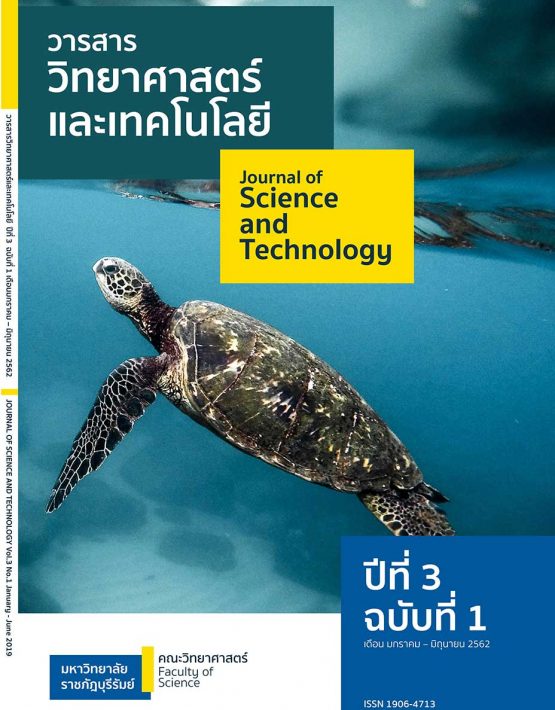การคัดแยกและคัดเลือกแบคทีเรียผลิตพอลีไฮดรอกซีอัลคาโนเอต จากดินบริเวณที่มีการปนเปื้อนน้ำมันในจังหวัดสงขลา
Main Article Content
บทคัดย่อ
การวิจัยนี้มีวัตถุประสงค์เพื่อคัดแยกและคัดเลือกแบคทีเรียที่มีความสามารถในการ ผลิตพอลิไฮดรอกซีอัลคาโนเอต (Polyhydroxyalkanoates: PHAs) จากดินที่มีการปนเปื้อน น้ํามันในจังหวัดสงขลาโดยใช้น้ํามันเหลือทิ้งจากการทอดปอเปี๊ยะเป็นแหล่งคาร์บอนในการเจริญ และสร้างพลังงานสะสมในรูปแกรนูลของพอลิไฮดรอกซีอัลคาโนเอต จากการคัดแยกแบคทีเรีย โดยวิธี Sensitive, Viable-Colony Staining Method พบแบคทีเรียที่สร้าง PHAs จํานวน 120 ไอโซเลท เมื่อคัดแยกจากลักษณะสัณฐานวิทยาที่แตกต่างกันพบเพียง 10 ไอโซเลทที่แตกต่างกัน ซึ่งเป็นแบคทีเรียแกรมบวก 7 ไอโซเลทและเป็นแบคทีเรียแกรมลบ 3 ไอโซเลท เมื่อทดสอบ ความสามารถในการเจริญในอาหาร Mineral Salts Mediนา (MSM) ที่มีน้ํามันเหลือทิ้งจาก การทอดปอเปี้ยะโดยการวัดน้ําหนักเซลล์แห้งพบว่า 3 ไอโซเลท SR 11 SR12 และ SR22 มีปริมาณน้ําหนักเซลล์แห้งสูงสุดโดยไอโซเลท SR22 ให้ปริมาณน้ําหนักเซลล์แห้งสูงสุดถึง 10.40 0.23 กรัมต่อลิตร นอกจากนี้ยังยืนยันผลการสร้างเม็ดแกรนูลของ PHAs ด้วยการย้อมสี Sudan Black B พบว่าทุกไอโซเลทมีการสร้าง PHAs เมื่อทดสอบคุณสมบัติทางชีวเคมีของ แบคทีเรียที่คัดเลือกได้ทั้ง 3 ไอโซเลท พบว่าไอโซเลท SR11 มีความคล้ายคลึงกับแบคทีเรียจีนัส Bacillus spp. ในขณะที่ ไอโซเลท SR12 และ SR22 มีความคล้ายคลึงกับแบคทีเรียจีนัส Pseudomonas spp.
Article Details
เนื้อหาและข้อมูลในบทความที่ลงตีพิมพ์ในวารสารวารสารวิทยาศาสตร์และเทคโนโลยีถือเป็นข้อคิดเห็นและความรับผิดชอบของผู้เขียนบทความโดยตรงซึ่งกองบรรณาธิการวารสาร ไม่จำเป็นต้องเห็นด้วย หรือร่วมรับผิดชอบใด ๆ
บทความ ข้อมูล เนื้อหา รูปภาพ ฯลฯ ที่ได้รับการตีพิมพ์ในวารสารวารสารวิทยาศาสตร์และเทคโนโลยีถือเป็นลิขสิทธิ์ของวารสารวารสารวิทยาศาสตร์และเทคโนโลยีหากบุคคลหรือหน่วยงานใดต้องการนำทั้งหมดหรือส่วนหนึ่งส่วนใดไปเผยแพร่ต่อหรือเพื่อกระทำการใด ๆ จะต้องได้รับอนุญาตเป็นลายลักษณ์อักษรจากวารสารวารสารวิทยาศาสตร์และเทคโนโลยี ก่อนเท่านั้น
เอกสารอ้างอิง
Al-Kaddo, K.B., Kumar, S. and Mohd, Razip S. (2016). “Screening of bacteria for PHA production using waste glycerol as carbon source and the ability of new strain to produce P(3HB-CO-3HV) copolymer,” Malaysian Journal of Microbiology. 12 (3) : 245-253.
Anbreen, A., Mohammad, Z., Khalid, M.Z., Aqdas, N., Muhammad, N. A. and Shazia, T. (2016). “Microbial production of polyhydroxyalkanoates (PHAS) and its copolymers: A review of recent advancements,” International Journal of Biological Macromolecules. 89 (1): 161–174.
Barham, P.J., Keller, A., Otun, E.L. and Holmes, P.A. (1984). “Crystallization and morphology of a bacterial thermoplastic: Poly-3-hydroxybutyrate,” Journal of Materials Science. 19 (9) : 2781-2794
Bhuwal, A.K., Gulab, Singh, N., Kumar, A., Varsha, G. and Anita, Y. (2013). "Isolation and screening of polyhydroxyalkanoates producing bacteria from pulp, paper, and cardboard industry wastes,”International Journal of Biomaterials. 2013: 1-10.
Gomaa, E.Z. (2014). “Production of polyhydroxyalkanoates (PHAS) By Bacillus subtilis and Escherichia coli grown on cane molasses fortified with ethanol,” Brazillian Archives of Biology and Technology. 57(1): 145-154.
Ludwig, W, Schleifer, K.H., and Whitman, W.B. (1989). Bergey's Manual of systematic bacteriology. USA : Springer.
Sasikumar, V., Priya, C., Shiv, S. and Sathish, S. (2014). “Isolation and preliminary screening of lignin degrading microbes,” Journal of Academia and Industrial Research. 3 (6): 291-294.
Spiekermann, P., Rehm, B.H., Kalscheuer, R., Baumeister, D. and Steinbüchel, A. (1999). “A sensitive, viable-colony staining method using Nile red for direct screening of bacteria that accumulate polyhydroxyalkanoic acids and other lipid storage compounds,” Archives of Microbiology. 171 (2): 73-80.
Tan, G.M., Chia-Lung, C., Ling, L., Liya, G., Lin, W., Indah M.N.R., Yanhong, L., Lei, Z., Yu, M. and Jing-Yuan, W. (2014). “Start a research on biopolymer polyhydroxyalkanoate (PHA): A review,” Polymers. 6 (1): 706-754.


